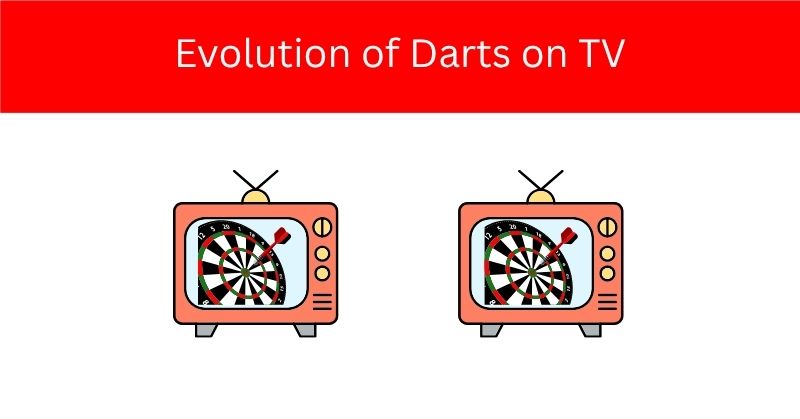This post may contain affiliate links which means we may receive a commission for purchases made through links. Read more on our affiliate disclosure.
Darts has come a long way since the days when it was just a pub pastime. The evolution of darts on TV has taken time, but during that period, the sport has made huge strides.
What started as a friendly game between mates has transformed into a global sporting spectacle, and much of that change is thanks to how darts has evolved on television.
From smoky halls and wooden dartboards on the BBC to glittering stages, booming crowds, and millions of viewers around the world, televised darts has helped turn the game into the professional sport we know today.
Here at Throw For 180, we’re ready to take a look at the fascinating journey of darts on TV, and how the cameras helped shape the modern game.
The Early Days of Darts on Television
Darts first made its way onto British television in the 1970s. The BBC and ITV both began broadcasting darts tournaments, giving pub players and fans a chance to see the game played at a professional level for the first time.
Shows like Indoor League introduced the sport to the wider public, and before long, events such as the News of the World Championship and the World Masters were pulling in huge viewing figures.
It was a golden age for working-class sport, relatable, down-to-earth, and full of characters. Players like Eric Bristow, John Lowe, and Jocky Wilson became household names.
These broadcasts captured the heart of the British public, and for a while, darts was one of the most watched sports on TV, darts news and competitions became mainstream.
But as the 1980s rolled into the 1990s, things began to change, and it all kicked off the evolution of darts on TV.
The Split and the Rise of the PDC
By the early 1990s, darts had lost some of its television appeal. Viewership dropped, and broadcasters started to scale back their coverage.
In 1992, a group of leading players decided to take control of their own future. They formed the World Darts Council (later renamed the Professional Darts Corporation, or PDC) and struck a deal with Sky Sports to bring a new style of darts to TV.
It was a bold move, but this new darts setup changed the sport forever.
The PDC introduced modern presentation, dedicated coverage, and an entertainment first approach. This was the evolution of darts coming to life, and it began setting the bar for what viewers at home, and those watching live in the arena, began to expect.
The stages got brighter, the crowds got louder, and the players became bigger stars than ever. Sky Sports’ high quality production and commitment to darts turned it back into a must watch event for fans across the UK.
The Sky Sports Era
If the early days made darts a TV hit, the Sky Sports era made it a global brand. If there’s one name responsible for the evolution of darts on TV, then Sky Sports is that name.
The PDC’s partnership with Sky introduced iconic tournaments such as the Premier League and the World Grand Prix to a massive audience. Production values improved dramatically, multiple camera angles, HD slow motion replays, and on screen graphics made darts exciting to watch.
Crowds added a whole new dimension. Walk on music, chanting fans, and electric atmospheres became part of the experience. Suddenly, darts wasn’t just a sport, it was an event. All of this brought even more challenges than ever before around the mental side of darts, but it was what took the game to a whole new level.
This era also saw the rise of new stars and big name pro darts players like Phil Taylor, Raymond van Barneveld, and later Michael van Gerwen, players who helped cement darts as a professional, elite level sport.
Modern Broadcasts and Global Reach
Today, darts on TV looks better than ever.
Matches are broadcast in high definition, streamed online, and watched by millions around the world. Sky Sports remains the main UK broadcaster for PDC darts, but the sport has expanded far beyond British television.
Networks across Europe, North America, and Asia now carry live events, while online platforms such as DAZN and Viaplay offer international coverage. Social media and YouTube have also made it easier than ever for fans to catch up on highlights, follow live stats, and watch interviews from anywhere in the world.
The professionalism and accessibility of modern broadcasts have helped darts reach new generations of fans, from casual viewers to serious players picking up their first set of darts.
How TV Changed the Game
Television didn’t just show darts, it transformed darts into what we have today.
The exposure brought sponsorship money, prize increases, and a massive rise in professionalism. Players began training harder, competing full time, and travelling the world for televised events.
It also changed how fans connected to the sport. Walk-ons, nicknames, and big personalities became part of the experience, turning players into entertainers as much as athletes.
In many ways, the evolution of darts on TV is the story of darts itself, a working class game that found its way into the hearts of millions, all through the power of the screen.
The Evolution of Darts on TV: Final Word
From smoky pubs to sold out arenas, darts has undergone an incredible transformation.
The sport’s rise on television has been at the heart of that journey, turning it from a niche pastime into one of the UK’s most beloved viewing traditions.
As technology continues to evolve, so too will the way fans watch and experience darts. But one thing is certain, the magic of darts on TV isn’t going anywhere.
